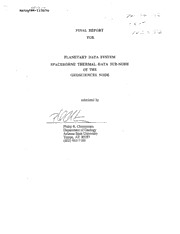
NASA Technical Reports Server (NTRS) 19980007297: Planetary Data System Spaceborne Thermal Data Sub-Node of the Geosciences Node PDF
Preview NASA Technical Reports Server (NTRS) 19980007297: Planetary Data System Spaceborne Thermal Data Sub-Node of the Geosciences Node
t'/.?- NA $ A/..T.M_ 1_1'/-3-056 , :, FINAL REPORT FOR PLANETARY DATA SYSTEM SPACEBORNE THERMAL DATA SUB-NODE OF THE GEOSCIENCES NODE submitted by PhilipR. Christensen Department ofGeology Arizona StateUniversity Tempe, AZ 85287 ((502)955-7I05 ARIZONA STATE UNIVERSITY SUB-NODE OF THE GEOSCIENCES NODE 1.0 Objectives The objectives of this proposal were: !) to assemble the existing spacecraft thermal-infrared data and to place these data into a uniform format as specified by the PDS; 2) to develop a standardized software package, user interface, and catalog database to support the access and analysis of existing and planned thermal infrared datasets in order to provide wide community access to these data; 3) to support the distribution of Thermal SubNode data to users as requested; 4) to incorporate future spacecraft thermal observations into the Thermal SubNode; and 5) to sponsor workshops on the applications of Thermal SubNode data. 2.0 Accomplishments 1) Completed the design and development, in conjunction with funding from the Mars Observer project, of a non-proprietary database software package (~25,000 lines of C code) for the efficient storage and retrieval of multi-spectral data. This package was developed for the PDS and is consistent with existing PDS standards. This database was designed for the use of Thermal Emission Spectrometer (TES) data and is referred to here as the TES Database (TDB). It was developed, however, as a generic spectral database for use in all space and laboratory spectral data. 2) Converted the Viking Infrared Thermal Mapper (IRTM) data into the TES Database (TDB) format developed. Two CD-ROM's have been produced that contain the Viking Orbiter 1 and 2 data respectively. 3) Developed a set of software to access and analyze IRTM data. This software package incorporates the functionality of earlier the PDS-sponsored package (RAD), but has been completely reorganized and simplified. It is developed entirely in C and includes an X-windows-based graphical user interface. This software package has undergone initial distribution and review. 4) Converted the Mariner 9 Infrared Interferometer Spectrometer (IRIS) data into the TDB format. 5) Developed an extensive spectral display and analysis package that accesses any datasets in the TDB. This package provides a significant set of standard tools (calibration, vector math manipulation, display, etc). 6) Began preliminary wc;rk to make all Thermal Sub-Node data accessible over Internet using Mosaic. 7) Began the acquisition of: 1) Mariner 6 and 7 IRS; 2) Mariner 9 IRR; 3) Mariner 10 IRR; and 4) Voyager IRIS spacecraft data sets for geoscience applications. 8) Supported the development of spectral analysis software to support scientific research using a broad range of existing spacecraft thermal observations. 9) Supported the distribution and analysis of Thermal Sub-Node data. 10) Developeda archive datasystemto archive Mars ObserverThermal Emission Spectromete(rTES)dataintotheThermalSub-Nodebeginningin 1993.Unfortunately thissystemwasneverutilizedduetothefailureoftheMarsObserverspacecraft. 4.0 Scientific Research Tasks 1) Studies were performed on the compositional units on the martian surface by determining the broadband thermal emissivity using IRTM data. 2) Studies were performed on the seasonal and temporal distribution of martian water-ice clouds and hazes using the IRTM data. 3) Initial work was done to reanalyze the Mariner 9 IRIS data in conjunction with IRTM data to study surface composition and surface compositional variations.
